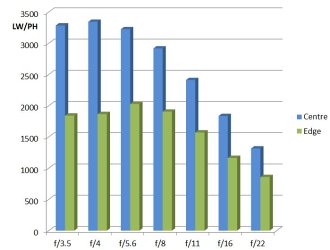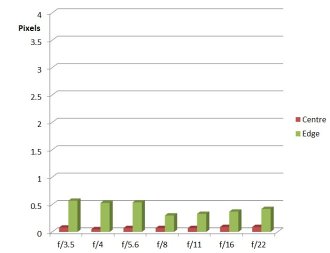Panasonic Lumix G Vario 12-60mm f/3.5-5.6 Review
Panasonic Lumix G Vario 12-60mm f/3.5-5.6 Asph. Performance
The behaviour of a zoom lens is complex and there are undeniably compromises that have to be made, especially with a compact lens. In this instance, performance seems to be biased towards the centre of the frame, right across the zoom range. Flare is hardly visible at all, a very commendable result.
How to read our charts
The blue column represents readings from the centre of the picture frame at the various apertures and the green is from the edges.The scale on the left side is an indication of actual image resolution as LW/PH and is described in detail above. The taller the column, the better the lens performance.
For this review, the lens was tested on a Panasonic Lumix GX8 using Imatest.
At 12mm, distortion measures -1.45% barrel. Barrel distortion, the bending outwards of straight lines, is to be expected in wide angle lenses and for a compact zoom this result is excellent. CA at the centre is very well controlled, less so at the edges, but still rather impressive.
How to read our charts
Chromatic aberration is the lens' inability to focus on the sensor or film all colours of visible light at the same point. Severe chromatic aberration gives a noticeable fringing or a halo effect around sharp edges within the picture. It can be cured in software.Apochromatic lenses have special lens elements (aspheric, extra-low dispersion etc) to minimise the problem, hence they usually cost more.
For this review, the lens was tested on a Panasonic Lumix GX8 using Imatest.
Sharpness at 12mm is outstanding centrally, from open aperture through to f/5.6. It is excellent at f/8 and f/11 and still very good at f/16, falling to only fair at f/22. The edges are not quite the same high standard, very good from f/3.5 to f/8, good at f/11 and fair at f/16 and f/22.
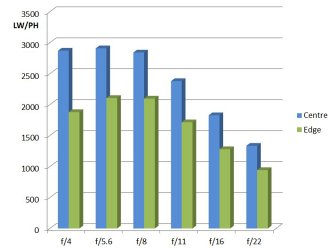 |
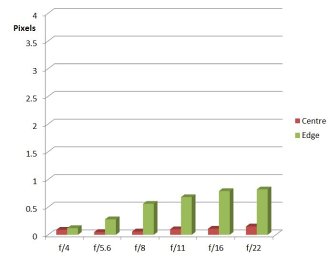 |
| MTF At 18mm (2nd) | CA At 18mm (2nd) |
At 18mm we find +0.543% pincushion distortion, the bending inwards of straight lines, but this figure is very low and in practical terms of little significance. CA continues to be very well under control, particularly at the centre.
Central sharpness at 18mm is excellent from open aperture to f/11, very good at f/16 and fair at f/22. The edges are very good from open aperture to f/8, good at f/11 and just fair at f/16 and f/22.
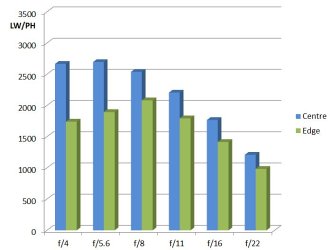 |
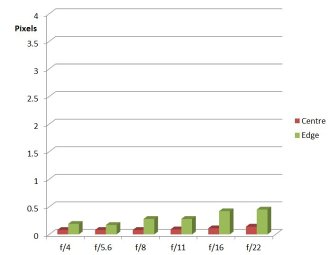 |
| MTF At 25mm (2nd) | CA At 25mm (2nd) |
At 25mm we see +0.444% pincushion distortion, another impressively low figure. CA likewise is still firmly under control and will not be a problem.
25mm sees excellent central sharpness from open aperture to f/8, very good at f/11 and f/16 and dropping to fair at f/22. The edges are very good at f/4 through to f/11, but only fair at f/16 and f/22.
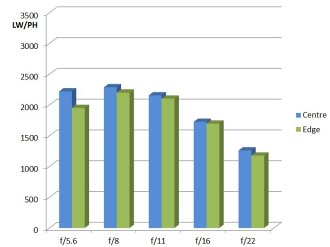 |
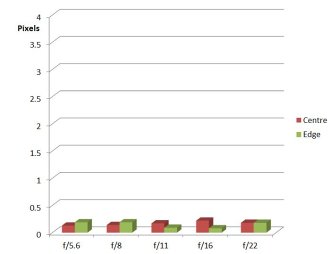 |
| MTF At 40mm (2nd) | CA At 40mm (2nd) |
At 40mm we have +0.0804% pincushion distortion, plus CA figures that are so low as to be very creditable for a compact zoom lens, indeed for any lens. This is a remarkable degree of correction.
40mm central sharpness is again very good from open aperture to f/11, good at f/16 and fair at f/22. The edges are not far behind off, being very good at f/5.6 to f/11, good at f/16 and fair at f/22.
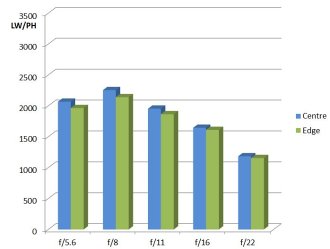 |
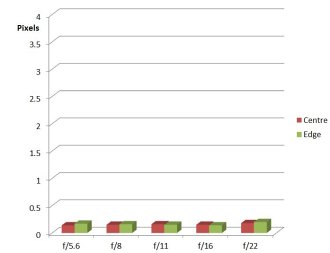 |
| MTF At 60mm (2nd) | CA At 60mm (2nd) |
60mm still keeps the distortion well under control, measuring +0.0518% pincushion. CA is virtually non-existent, again as before.
60mm sharpness is very good centre and edge from f/5.6 to f/11, good at f/16 and fair at f/22. Centre and edge have become much more even as we move to the longest telephoto setting.
In summary, the lens starts off very strongly at the wider angles, slowly reducing in sharpness as we zoom. The edges never equal the centre, but become more evenly matched as we approach 60mm. At the widest angle, the central sharpness is outstanding. The low distortion and CA figures are remarkable.
The IS system seems to offer around 2-3 stops advantage, enabling the use of slower shutter speeds than would otherwise be the case. As the light fails this will mean sharper shots, something that is becoming essential for travel shooting.
The bokeh of the lens is perhaps slightly fussy, but it is not surprising with just 7 diaphragm blades. It is certainly not unpleasant and the slightly softer telephoto images will lens themselves well to giving pleasing out of focus areas. This could be where the portrait photographers will find some highly effective effects.
Value For Money
The Panasonic Lumix 12-60mm does seem to slot into a new niche for MFT photographers. At £359, that seems a very fair price.
The nearest equivalent might be the Olympus 12-50mm f/3.5-6.3 Zuiko Digital ED EZ, priced at £279. However, this is not as long a telephoto, nor is the aperture as fast at the long end.
Other marques do have their own offerings, and just to put it into perspective, the Nikon 24-120mm f/4 G AF-S ED VR costs £849. All the other close alternatives that start at 24mm are not as long at the telephoto end.
So, for now at least, Panasonic seem to have the only MFT lens in its class. For more options have a look at the Top 7 Best Panasonic Lenses.
Add your message
Please login here or if you've not registered, you can register here. Registering is safe, quick and free.
photodo Stats
428 MTF tests
74 in-depth photodo reviews
100+ users join each day
Help the lens community by reviewing or rating a lens today via our lens search
Latest Lens Reviews
- Chinon 28mm f/2.8 Vintage Lens Review
- Canon EF 70-200mm f/4L IS II USM Lens Review
- Samyang AF 85mm f/1.4 EF Review
- Sigma 70mm f/2.8 DG Macro Art Review
- Samyang AF 24mm f/2.8 FE Review
- Meike 50mm f/1.7 Review
- Tamron 70-210mm f/4 Di VC USD Review
- Lensbaby Burnside 35mm f/2.8 Review
- Asahi Super Takumar 50mm f/1.4 Review
- Asahi Super-Multi-Coated Takumar 135mm f/3.5 Review
